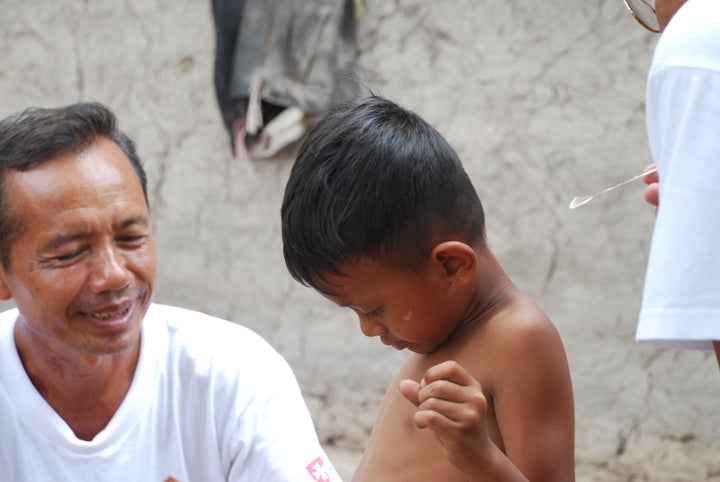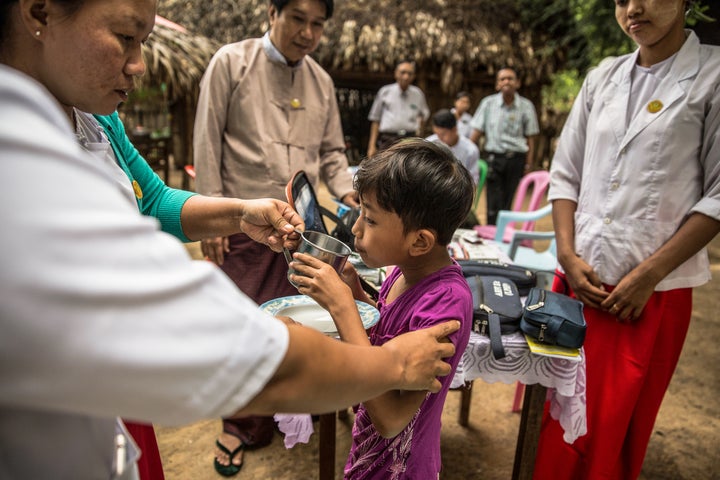In the small village of Dana Toc in Myanmar, community organizers are engaged in the task of gathering all their neighbors to be tested for one of the oldest documented diseases: leprosy.
In Dana Toc, 72-year-old widow Daw Khin Thein was diagnosed in the same way that people have been diagnosed for centuries – with a feather. As there is no existing reliable diagnostic test for the disease, a feather is run over the skin to detect areas of numbness, which is indicative of the nerve damage caused by leprosy.
Commonly thought to be a disease of the ancient past, leprosy continues to affect thousands of people each year. Between 200,000 and 250,000 new patients are diagnosed annually.

A young boy in Cambodia is screened for leprosy symptoms with the use of a feather.
Thanks to medical advances, leprosy can be treated with multi-drug therapy (MDT) once diagnosed. Not only is MDT effective at curing leprosy, it helps reduce transmission and prevent permanent disability. Since this therapy became freely available worldwide, there has been a dramatic decrease in annual diagnoses of leprosy. Yet it can only be administered once a diagnosis has been made, and as it can take up to 20 years before patients become symptomatic, during this time leprosy can be unknowingly transmitted.
In the absence of a better diagnostic tool, the most effective way to interrupt transmission and eliminate leprosy is contact tracing.
Contact tracing identifies and diagnoses people who may have come into contact with an infected person, which helps toward earlier diagnosis. This is one of the approaches the Novartis Foundation is taking to help work toward final elimination of the disease.
In 2014, the Novartis Foundation and its partners launched the leprosy post-exposure prophylaxis (LPEP) program. This program focuses on interrupting the transmission of leprosy by ensuring all those who may have been exposed are examined and offered a post-exposure prophylaxis, which can reduce the risk of developing leprosy by 50-60%.
Since its launch, LPEP has been expanded to Indonesia, India, Nepal, Myanmar, Tanzania and Sri Lanka, while Brazil and Cambodia have introduced similar approaches. We are excited to see this program expand, making progress toward interrupting leprosy transmission.
The NTD Summit, five years after the London Declaration, gives us new momentum to meet the goals outlined by the WHO’s Roadmap on NTDs. These goals include continuing to work together to make leprosy history. This is an ambitious goal, but it is one the Novartis Foundation is committed to, and one I believe we can achieve.
To cover the last mile toward leprosy elimination, we must leverage and scale proven solutions, while also investing in research for improved diagnosis methods. The LPEP program is an excellent example of a program that can be scaled and taken to other leprosy-endemic countries, and we are proud of the success it has had.

A child in Myanmar drinks water to help her swallow her dose of the post-exposure prophylaxis, Rifampicin.
The Novartis Foundation is also working to develop a diagnostic tool, by collaborating with research partners to develop a leprosy molecular diagnostic test. The hope is that, once this test is developed, leprosy can be diagnosed before significant nerve damage has taken place and before it is unknowingly transmitted to others.
Cases of leprosy have plateaued in the past few years: it is increasingly difficult to make significant reductions when diagnosis is so difficult. Without an effective diagnostic test, we are left to work with the centuries-old technique of using a feather.
But by leveraging interventions that work and continuing research into developing effective diagnostic tools, I am certain that we can reach the final elimination of leprosy together.
This article is part HuffPost’s Project Zero campaign, a yearlong series on neglected tropical diseases and efforts to eliminate them. This series is supported, in part, by funding from the Bill & Melinda Gates Foundation. All content is editorially independent, with no influence or input from the foundation. If you’d like to contribute a post to the series, send an email to ProjectZero@huffingtonpost.com. And follow the conversation on social media by using the hashtag #ProjectZero.
